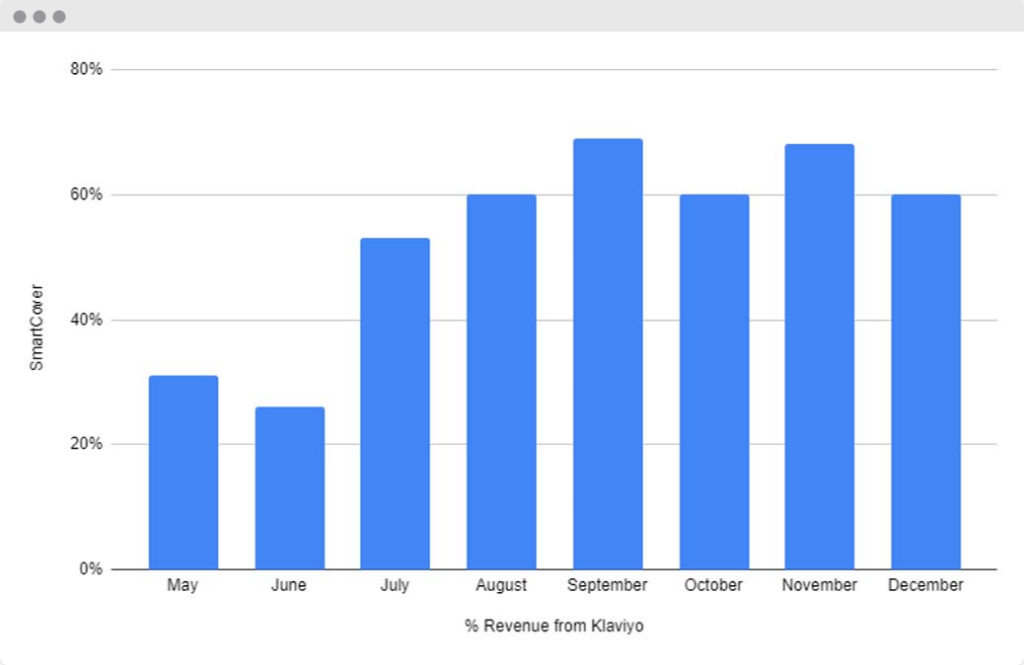Matteo Grassi Co-Founder & CEO of @popup

A true master in retention marketing. I have been working with many agencies and freelancers but George has brought the best results combined with an outstanding work ethic.

Client: Viceroy Group
Industry: Healthcare.
List Size: 100K~
ESP: Klaviyo.

1. Few customers bought more than once.
2. The company grew too fast without
developing a solid email marketing strategy.

1. Get repeat sales and increase email revenue share.
2. Maintain a positive customer experience.

1. 93% increase of rebuy rate.
2. Average of 53% of total store revenue came from Klaviyo in the past 6 months.
#1: The companies that win in retention are customer-centric and have a product that allows repeat sales.
#2: Discounts have their place, but they don’t build loyalty. You need to create a positive customer experience to have a happy customer.
#3: The game starts on the ad that leads people to the sign-up form and finishes at the sale way after the sale.
Our client is an eCommerce store, part of the Viceroy Group. Its product catalog includes solutions for better health, sleep, and productivity, such as sleep masks, earplugs, laptop sleeves, hand sanizeters, and more. However, the best-selling products were related to the COVID pandemic. Naturally, the motivation to buy was high, leading to incredibly fast growth (to the tune of 10M+ in sales in only one year).
The pandemic-fueled growth of the store was incredibly quick. Viceroy’s team simply had no time to develop an in-depth and personalized email marketing strategy. This is why they decided to work with us.
When we found them, they had already developed the fundamentals. The core flow automations were set up, and there was a regular cadence of campaigns. A sizable list of around 100,000 subscribers was waiting to be analyzed and then profitably mined.
And yet, despite this seemingly healthy situation, we quickly spotted a sizable problem. The customer rebuy rate was sitting at only 12%. Much lower than we initially suspected.

We started by launching multiple pre-sale and after-sale user surveys to better understand the situation. In parallel, we sliced and diced the customer database into more profitable segments, spotting key insights along the way – including a giant discrepancy between the store’s winbacks and the customers’ average days between orders.
Then we started mapping the customer journeys visually using the tool miro. This is a very practical way to immediately spot opportunities and gaps and start prioritizing them by impact. The rule of thumb is simple: If it affects a lot of people, such as a problematic welcome flow, start there first.
After a few days of work, we came up with clear action steps. Our goal was to build a seamless customer journey.
Some of our core objectives were:
Let’s take a closer look at some key steps.

Engagement-based segments work great. But we took things to a much more sophisticated level, blending in qualitative research data, email engagement, and shopping behavior to create truly granular experiences.
In essence, this allows the customers to ‘choose their own adventure’ with the brand, increasing customer satisfaction score through personalized, positive experiences.

We love flows. They work all day, every day – for free (well, almost). After we fully set up the store’s automation engine to profitably acquire and retain customers (part of which we described in the previous section), we started experimenting.
One of the things we tested successfully was the 3-pronged sunset strategy. A way to filter out unengaged subscribers on autopilot on 3 critical moments.

Delivering a discount is just one of the many possible functions a sign-up form can have. We maximized the value of our onboarding by creating personalized journeys based on the user’s preferences, collected via the signup forms. It’s an amazing and shockingly underutilized way to conduct user research, at scale, in a passive way.

We A/B tested our way into developing a smart campaign strategy that soon became the mainstay of our email marketing plan. Our content calendar is a mixture of educational emails, sales and promotions, seasonal content, and experimental angles, such as driving engagement through meme marketing.
#1: 93% increase in customer retention rate.
12.44%
Customer rebuy rate before.
24.075%
Customer rebuy rate after.
#2: Average revenue from email – 53%.

Not really. A well-oiled email marketing strategy doesn’t go out of fashion, but it’s ALWAYS subject to analysis, testing, and optimization of marketing tactics. We continue to push to drive more learnings and bigger financial wins for Viceroy Group. Just like we do for every single one of our clients. Just like we could, potentially, for your brand too.
Getting started is easy. We’ll have a short, no-obligation call to meet each other. If we’re not a good fit for whatever reason, we will refer you to an agency that can serve you better than we could. If we are, we’ll start with a quick audit of your email program. And if you’re thrilled with the results of that audit (experience shows you will be), we’ll sign you up for a monthly retainer and start implementation right away.
Do you need
to maximize your
profits?